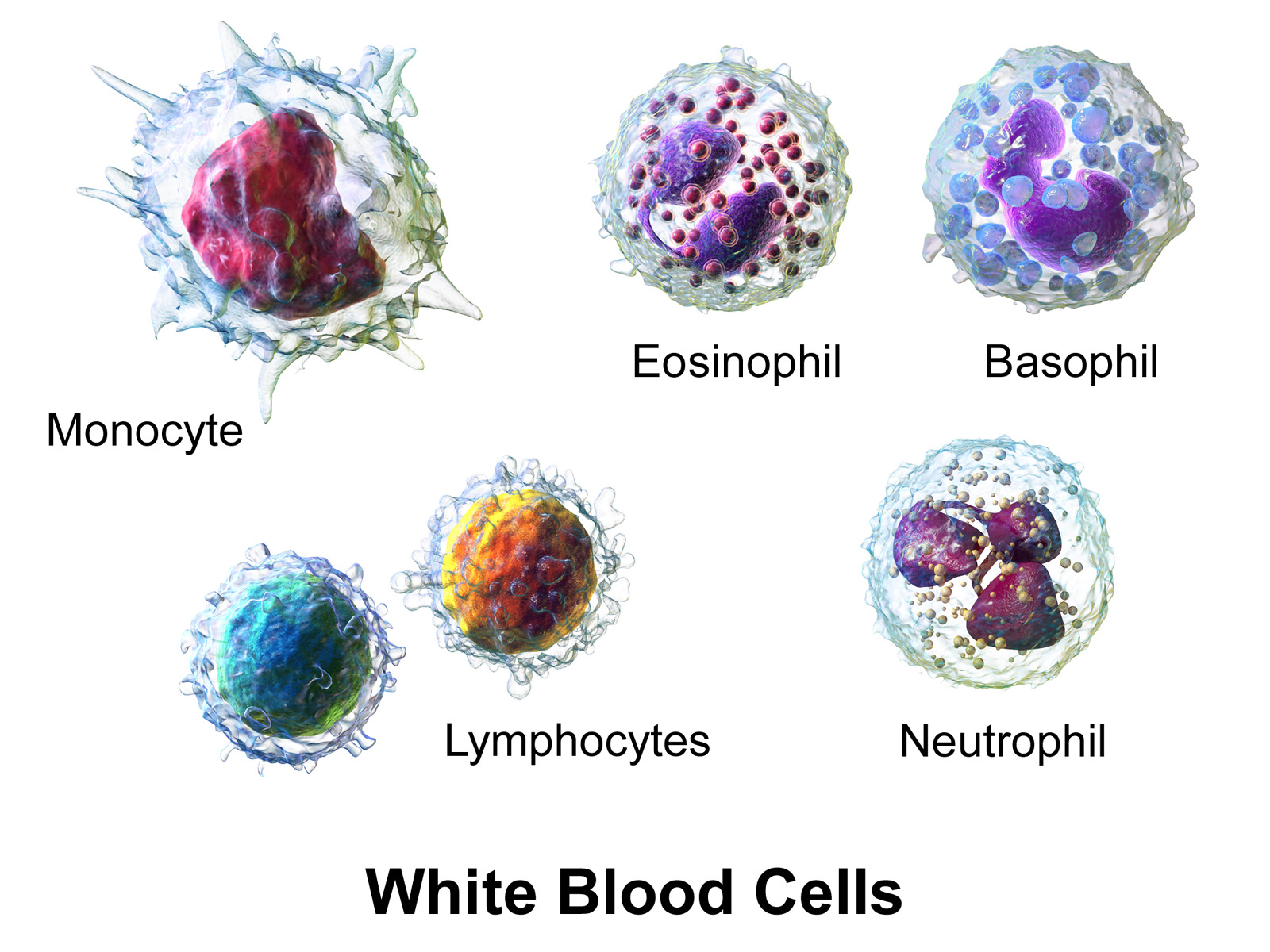Playlist
Show Playlist
Hide Playlist
Lymphadenopathy: Follicular Lymphoma and Lymphoid Hyperplasia – White Blood Cell Pathology
-
Slides Lymph Nodes.pdf
-
Download Lecture Overview
00:01 Our first major non-Hodgkin lymphoma that we'll take a look at will be follicular lymphoma. 00:06 Let's go straight to the point. There's a translocation taking place in t(14;18). 00:12 This t(14;18) is then going to overexpress BCL-2. 00:15 Before we move on, BCL-2 is going to do what with cytochrome C from the mitochondria? Our discussion, apoptosis, remember, this is a cancer that will do everything in its power to upregulate anti-apoptopic factors. 00:31 So, therefore, BCL-2, if upregulated, prevents the release of cytochrome C from the mitochondria, you're not going to activate caspase, and you've inhibited apoptosis. 00:43 Cuz increased survival of your germinal center, I'll show you a picture in which follicular lymphoma, in your lymph node, and non-Hodgkin lymphoma, a common one, by the way, is involvement of your follicular, follicular portion of the lymph node. 01:01 And you find this to be extremely, extremely expanded and active, and it's important time I wish to mention here as well, that 30-40% of the time, a follicular lymphoma may actually then go on to diffuse large B-cell lymphoma. 01:17 We'll talk about different ways that you'll be responsible for developing diffuse large B-cell lymphoma for your boards. 01:23 One method might be from follicular lymphoma. 01:26 If you find a diffuse large B-cell lymphoma having translocation(14;18), you know for a fact that it came from follicular lymphoma. 01:35 The description of morphology in follicular lymphoma, in the lymph node, which is where the problem begin, you would find enlarged lymph node, consisting of small cleaved lymphocytes. 01:51 If you're gonna take a look at a lymph node, you'll find in the middle there, huge areas of the follicle that are just about engrossing this entire follicle. 02:03 Quite a bit of increase in size of the follicle. 02:07 Upon a closer examination, here, once again, you find in the middle, quite a bit of small, cleaved lymphocytes in which you find follicular activity to be extremely prevalent. 02:21 This is follicular lymphoma tranlocation(14;18). 02:26 Upregulation of BCL-2, these cancer cells, these B cells, are going to remain alive forever. 02:32 Our topic here, an important differential is the fact that you might have reactive lymphoid hyperplasia versus follicular lymphoma. 02:42 The immunohistochemistry stain, at least be able to identify what's known as spectrin staining. 02:49 And you're focused here, I'd like for you to take a look at, would be reactive type of your lymphoid hyperplasia. 02:56 Reactive, not a cancer per say, so you would still have increased activity of your follicle based on the reaction that's taken place, maybe perhaps your infection and so, therefore, how would you able to differentiate this from follicular lymphoma? Spectrin staining would then help you. 03:15 Now, what you're seeing here would be the germinal center, which is quite active, and you have an area that's the mantle, and then outside of this, you would have your paracortex. 03:26 What you also would find is that, well, strongly expression of spectrin. 03:32 The numerous tangible-body macrophages or wherever in the middle, do not, do not appear to take up your spectrin. 03:41 However, the T-zone, paracortex, however, will. 03:45 And this is quite important for you to differentiate reactive lymphoid hyperplasia versus what we'll take a look at with follicular lymphoma. 03:53 In follicular lymphoma, what you end up finding is going to be positive spectrin staining in what kind of cells? B-cells. And B-cells are located where? In the follicle. Let's stop here. 04:09 Make sure that you truly understand how to differential reactive lymphoid hyperplasia and which it's responding to an invader versus follicular lymphoma which is going to be a cancer. 04:23 If you remember correctly, if it's an acute type of reaction, the paracortex is going to come in play and it's going to start activating, well, T-cells, And you need CD4 and you need CD8. 04:35 And because of this, the spectrin will be taking up by the T-cells, and therefore, the anatomy of the lymph node now becomes in handy. 04:43 The T cells reside where in your lymph node? Paracortex. 04:48 Next, if you're thinking about follicular lymphoma, what kind of lymphoma is this? A non-Hodgkin lymphoma of the follicle and what kind of cells are involved? B-cells. So, now the B-cells are going to start taking up your spectron. 05:04 You'd expect this to occur in your follicle as you see in the picture. 05:11 In non-Hodgkin lymphoma, or commonly known as follicular lymphoma, remind me again what the translocation here is? Good, t(14;18). It is one of the most common types of non-Hodgkin lymphoma. 05:24 Remember that three of the non-Hodgkin lymphoma known as number one, diffuse large B-cell lymphoma, follicular lymphoma, and also, well, chronic lymphocytic leukemia/small lymphocytic lymphoma. 05:35 These three approximately comprise 70 to 75% of all non-Hodgkin lymphomas. 05:40 So, no doubt, follicular lymphoma is one of the most common. 05:43 Usually will present in middle age and this particular patient who has lymphadenopathy is not going to be complaining of pain, correct? Cuz this is a cancer, non-tender. 05:53 Radiation is a very effective treatment when used early in cases. 05:57 And can even be cured for some patients with stage 1 disease. 06:00 Advanced cases on the other hand are relatively intensive to chemotherapy. 06:04 Their treatment may still be used in a palate of manor to help with symptom control. 06:07 Now, it's indolent, however, there is every possibility. 06:11 Look at this percentage, this is no joke. 06:14 In approximate, 30-50% of your follicular lymphomas may then go on to A, more aggressive form of, well, you guessed it, diffuse large B-cell lymphoma. 06:22 Otherwise, it is rather indolent in course. 06:25 So, let's say that you do a biopsy of the lymph node and you find that the population here is diffuse type of large B-cells and you find the translocation to be t(14;18), where do you think it came from? Good, it rose from follicular lymphoma. 06:39 This, however, is not equivalent to Richter syndrome. 06:42 Remember, Richter syndrome is the development of diffuse large B-cell lymphoma from which particular non-Hodgkin lymphoma? Good, the chronic lymphocytic leukemia/small lymphocytic lymphoma.
About the Lecture
The lecture Lymphadenopathy: Follicular Lymphoma and Lymphoid Hyperplasia – White Blood Cell Pathology by Carlo Raj, MD is from the course Lymphadenopathy – White Blood Cell Pathology (WBC).
Included Quiz Questions
Which translocation is associated with most follicular lymphomas?
- t(14;18)
- t(8;14)
- t(8;21)
- t(11;14)
- t(11;18)
What is the function of The regulatory protein BCL2?
- Inhibition of apoptosis
- Autophagy
- Ferroptosis
- Promotes apoptosis
- Inhibition of necroptosis
What is the most common type of non-Hodgkin lymphoma?
- Diffuse large B-cell lymphoma
- Mantle cell lymphoma
- Burkitt lymphoma
- Small lymphocytic lymphoma
- Primary mediastinal large B-cell lymphoma
Which of the following is the most accurate description of the histological features of follicular lymphoma?
- Positive II spectrin staining in neoplastic B-cell nodule and in surrounding reactive lymphocytes
- Hyperchromatic and pleomorphic spindled endothelial cells
- Germinal hyperplasia and large, abnormal, nonneoplastic T lymphocytes
- The B-cell follicle has a germinal center and a mantle zone and surrounding paracortical T zone expressing II spectrin.
- Atypical neoplastic lymphoid cells
Customer reviews
5,0 of 5 stars
| 5 Stars |
|
5 |
| 4 Stars |
|
0 |
| 3 Stars |
|
0 |
| 2 Stars |
|
0 |
| 1 Star |
|
0 |






